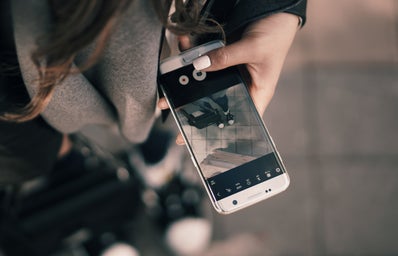After snapping a photo with your besties, you eagerly gather around to watch the photo develop. But, as the minutes pass, your excited anticipation is replaced with disappointment: the photo is still blank.
Why didn’t the photo develop?
Sometimes, photos captured on the “Instax Mini 9” camera’s appear underdeveloped, and it’s typically because the setting goes unaltered. The camera has a light meter that causes a red light to appear above an icon on the exposure dial to indicate which setting to use, and some photographers may neglect this recommendation because they have their own personal preference on how they want their images to look. Or, in the excitement of snapping a cute picture, the photographer forgets to alter the dial accordingly. While there are other factors that could cause a photo to appear underdeveloped, like the film’s previous exposure to light or not loading it into the camera correctly, for the sake of this article, we’re just going to focus on the exposure dial.
So what does the exposure dial do, exactly?
For those who are unfamiliar with photography, the exposure dial works in accordance with the aperture, and the opening of the lens and the light. The larger the opening, the more light is let in. Alongside this, the smaller the number is, the larger the opening is. As shown in this picture below, the indoor setting lets in the least light because the rooms are usually dimly lit, and so the flash would be enough to make it appear more vivid. Conversely, the sunniest setting lets in the least amount of light because it is already very bright outside, and too much light would wash the image completely.
Ok, so now I know the different settings. How do I use them in practice so that I don’t waste my film?
It requires a bit of experimentation. I took my camera, an “Instax Mini 9”, on a stroll around the UMass Amherst campus to try and find locations with different types of lighting in order to utilize the camera’s various features. By taking shots of several objects, and purposefully using the “wrong” setting in order to highlight the differences between the images, I was able to bring light to this dilemma.
“Very Sunny” vs. “Hi-Key”: Here, the brightest setting, “Very Sunny”, and the least bright setting, “Hi-Key”, are compared side by side.
Shot 1: Using “High Key”
Great when… taking portraits of people.
Watch out for… lighting that is too bright, as it could wash out facial features.
Shot 2: Indoors
Great when… taking pictures in environments with low lighting.
Watch out for… the effect of the flash on the picture. More apparent in mirror pictures, or when capturing reflective objects, the outside of the image can be darker than the focus at the center.
Shot 3: Cloudy
Great when… capturing colors vividly, like the bright red!
Watch out for… the distance that the camera can cover. Here, the first few bikes are seen clearly, but the ones further away are significantly darker.
Shot 4: Sunny
Great when… you want your photos to have a darker flair.
Watch out for… when your pictures appearing too dark.
Shot 5: Very Sunny
Great when… capturing golden hour.
Watch out for… the ways certain shadows fall during this time of day.
Think you’ve got the exposure dial down? Go out and test some of your own shots now!
Images: 1, all other images curtosey of the author



